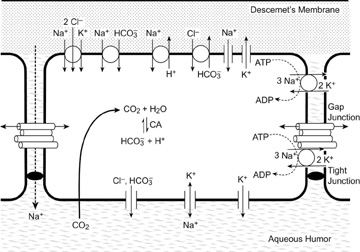

|
| Fig. 28. Transporters and channels identified in corneal endothelial cells. Cells are connected by apicolateral macula occludens type tight junctions and by lateral gap junctions that allow for intercellular communication within the monolayer. A Na+ concentration gradient and negative intercellular potential is set up by the basolateral Na+/K+ ATPase, which allows Na+ to enter the cell via a Na+/H+ exchanger, Na+/HCO3− and Na+/K+/2Cl− co-transporters, and Na+ permeable channels. K+ leaves the cell via the Na+/K+ ATPase, down its concentration gradient through at least two different K+ channels and through the nonselective cation channel. CO2 diffuses across the membrane from the aqueous humor, where it combines with H2O in the presence of carbonic anhydrase (CA) to form HCO3− and H+. The H+ leaves the cell through the Na+/H+ exchanger, and HCO3− exits via an exchanger and anion channels. The Cl− can then exit down its electrical gradient via anion channels on the apical membrane. |